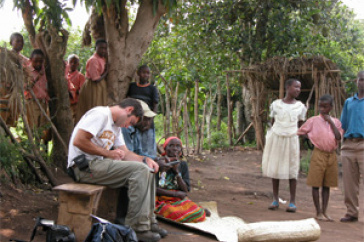UNH Receives National Science Foundation Grant to Study Changes in Climate, Population, and Land Use in Africa

Hartter conducts an interview with his long-time field assistant and interpreter Erimosi Agaba with a local resident from the Batoro tribe in a village near Kibale National Park. Oftentimes, curious neighbors show up.
DURHAM, N.H. - The University of New Hampshire has received a National Science Foundation grant to study changes in land use and conservation around national parks in Africa as part of a larger investigation of tropical deforestation and degradation, which are major causes of global climate change.
Joel Hartter, assistant professor of geography at UNH, is the principal investigator on the project, which is part of the NSF's Dynamics of Coupled Natural and Human Systems Program. The research team also includes Michael Palace of UNH's Institute for the Study of Earth, Oceans and Space; Colin Chapman of McGill University; Jeremy Diem of Georgia State University; and Sadie Ryan of the State University of New York's College of Environmental Science and Forestry.
Since 2004, Hartter has been examining park-people relationships in more than 100 communities outside Kibale National Park, a small forest park along the equator in Uganda known for its large population of endangered chimpanzees.
"Unlike past work focused on one national park, this project will contribute a fresh perspective on the impacts of population growth and climate change across seven national park landscapes. While there have been assessments of forest loss, agricultural expansion, population growth, and climate change in various parts of Africa, there has been little effort to integrate these components," Hartter said of the $250,000 grant.
Researchers will investigate the Albertine Rift in western Uganda, one of Africa's biodiversity hotspots, and an area prone to conservation conflict induced by surrounding poverty. Several national parks have been established in the area to protect several animal species, including critically endangered primates such as chimpanzees and mountain gorillas, living there. The researchers will examine the impacts of population growth, agricultural, and climate change around these parks.
"The establishment of national parks has been a major mechanism used to protect remaining tropical forest biodiversity, particularly in regions with high human densities. This juxtaposition of biodiversity preservation and agricultural expansion in hotspots greatly challenges both the intentions of conservation infrastructure and efforts to alleviate poverty," the researchers said.
"Quantifying where these areas occur on the landscape, and analyzing how local people perceive and respond to impacts is fundamental to understanding and facing this dual challenge," they said.
Researchers also are interested in whether global climate change might be causing additional impacts on forests, as well as agricultural lands -- prompting people to alter farming practices, which could lead to even more intense agricultural development and loss of forests, and human-wildlife conflict outside the park.
Using data from the project, the Geographic Information System Laboratory at UNH's Complex Systems Research Center will build a web application map using Google Earth for data delivery and visualization that can be accessed anywhere with an internet connection. This application will be used to visualize hotspots of change and assist in conservation efforts for national park officials, government representatives, and local people.
The University of New Hampshire, founded in 1866, is a world-class public research university with the feel of a New England liberal arts college. A land, sea, and space-grant university, UNH is the state's flagship public institution, enrolling 12,200 undergraduate and 2,300 graduate students.
PHOTOS
/unhtoday/sites/default/files/newsroom/img/hartter_map.jpg
Seven national parks in the Albertine Rift of East Africa that are part of the research study area. Kibale National Park, the primary focus of this project, is a refuge for endangered chimpanzees and other primates but surrounded by some of the densest rural populations in Africa.
/unhtoday/sites/default/files/newsroom/img/hartter_a.jpg
Hartter conducts an interview with his field assistant and interpreter Peace Mwesigwe with a local resident from the Bakiga tribe in a village near Kibale National Park.
/unhtoday/sites/default/files/newsroom/img/hartter_b.jpg
Hartter speaks with with his long-time field assistant and interpreter Erimosi Agaba.
/unhtoday/sites/default/files/newsroom/img/hartter_c.jpg
Hartter conducts an interview with his long-time field assistant and interpreter Erimosi Agaba with a local resident from the Batoro tribe in a village near Kibale National Park. Oftentimes, curious neighbors show up.
/unhtoday/sites/default/files/newsroom/img/hartter_d.jpg
Joel Hartter with local residents outside Queen Elizabeth National Park in July 2011.
-30-
Latest News
-
October 8, 2025
-
October 2, 2025
-
September 24, 2025
-
September 15, 2025
-
August 21, 2025














































